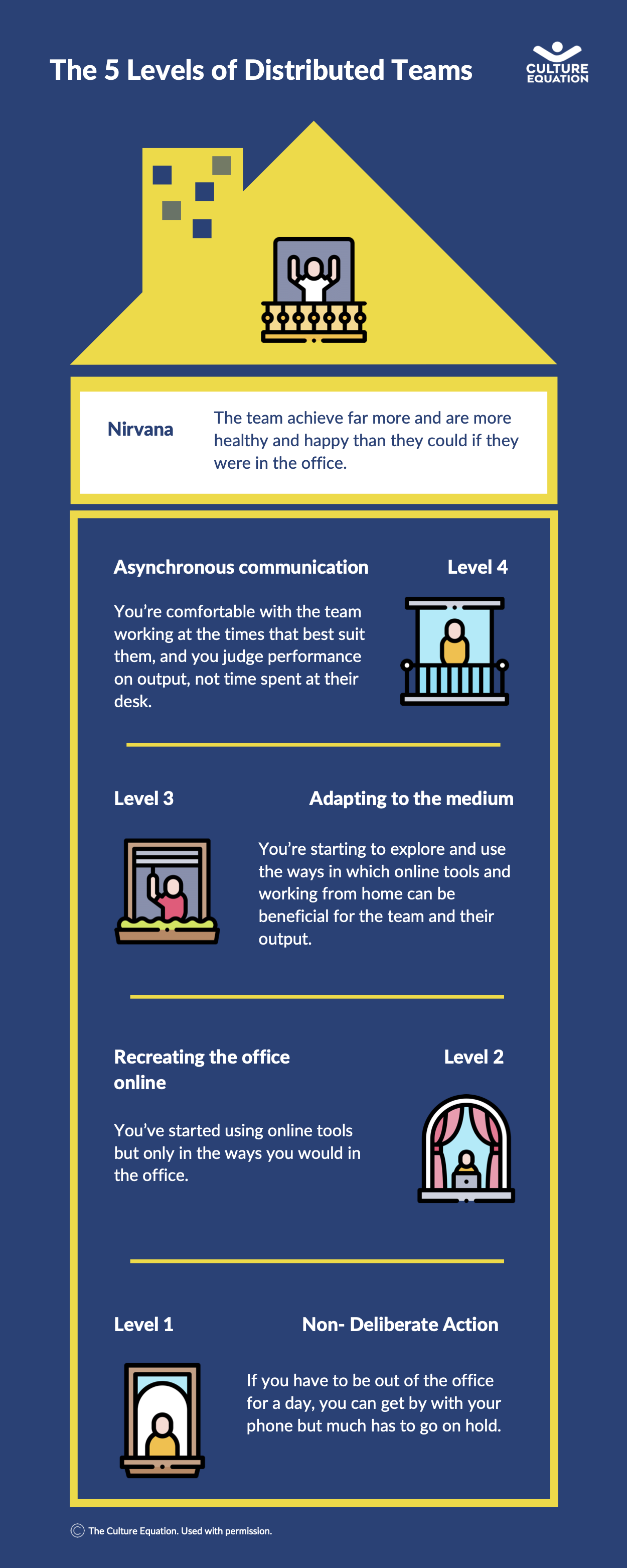Expert Interview: Hiam Sakakini on high performing teams and collaborative work management
2020-07-09
If you have been following my research into collaborative work management, you will know that I started my discovery process talking to vendors to understand better the problems they are trying to solve. I am continuing to talk to vendors and expanding the scope of my engagement, but I'm also using those insights to start further conversations with product users and other experts.
I recently spoke to Hiam Sakakini, Founder & CEO, The Culture Equation. Hiam spent nine years working at Google to help develop the skills and capabilities of their people, teams, and managers. However, I met her through her involvement with the Cerebral Palsy Alliance, where we have both been mentors for Remarkable, Australia's first disability-focused impact accelerator. At the Culture Equation, Hiam works with large organisations that wish to shift or sometimes completely transform their culture. More often, Hiam gets called in when a new executive leader is transitioning into their new role and needs to understand the culture of the organisation they are leading from an external viewpoint.

Hiam isn't a technologist, but her knowledge of how teams work, agile practices, and an appreciation of workplace technology makes her an ideal person to talk about the people aspects of collaborative work management.
Our conversation started with Hiam explaining more about her approach to building the capabilities of teams.
"Google puts a huge amount of effort into organisational design, and from that experience, I understand the components of how to build a great culture. In my role in leadership development for Google, I also saw what great leaders do differently. At The Culture Equation, our approach is based on an underpinning of great culture and great leadership. We help organisations to develop high performing cultures, which we define as empowered teams who trust each other and can innovate their way through challenges.
What comes first: technology or changing work practices?
Many of the solutions under the umbrella of collaborative work management are intended to support agile practices or practices inspired by it, such as kanban. Having spoken to other people about the relationship between technology adoption and practice development, mainly when people have found themselves suddenly remote, I wanted to know if Hiam thought the combination of Covid-19 and technology was a good way to drive culture change?
"I think this could be a catalyst, but you're not going to get the organisational level change needed. You will be fortunate if it spreads organically, and I think there is a temptation to start with technology. What has often happened is that people say, well we want a customer-centric culture, so we need to do Agile. And if we want to do our job that way, then we need to implement Microsoft Teams or something else."
"But I would say, hang on a second. This is a bit of a trick question because the natural response is to look to either the leadership team or another team that can set the example for how everybody else should be collaborating across the organisation. But how do you know either is working as a high performing team? I say, let's do some discovery and some diagnostics first. Let's drive culture change at the top first or it will have little chance of succeeding in the long term."
Diagnosing high performing teams
Hiam went on to explain how Google research into high performing teams, Project Aristotle, provides a model for understanding what consistently high performing teams do differently. I won't go over this in detail here, but in order of importance there are the factors:
- Psychological Safety
- Dependability
- Structure and Clarity
- Meaning
- Impact
It is also worth noting that Google's research found that co-location of teammates was not significantly connected with team effectiveness.
At the start of my conversation with Hiam, I felt that empowerment was a central issue, and she told me later that, "I think people feel empowered because they feel included."
"But this means knowing what their neighbour is doing, not just the person in their team. So when I see an obvious area that we should be working together that's in the interests of both teams that will benefit the customer, you feel empowered to walk over to your colleague and say we should collaborate. This means ignoring structural silos for the benefit of the customer."
Empowering teams and leaders
Hiam said that "Normally when I talk about empowering teams I talk about constructing the cultural pillars that guide behaviour in your absence such as the companies Values, Purpose and Vision. These clear signals and guidelines give each person a sense of what is important to focus on and how to go about achieving their goals through accepted behavioural norms."
So does any of this fit with the three attributes I identified as being common to any collaborative work management solution? They were:
- They help people to achieve objectives as a team of teams.
- They provide people with access to an authoritative, shared source of information.
- They become embedded in the flow of work through no-code or low-code automation and integrations.
I think on one level, we could argue that they support the intent of the cultural pillars Hiam talks about. Being collaborative could also be considered as a value that many organisations aspire to being. However, in the absence of clear signals and guidelines, I can see that collaborative work management solutions could easily be used simply as task management tools or even worse, put into the service of management control.
Putting these alongside Google's findings, I can see I might need to be slightly more nuanced in how those attributes apply to different collaborative work solutions.
Psychological Safety I would classify as a fundamental requirement. But for the others, it may be necessary to divide collaborative work solutions into two broad categories. There are those that lean towards addressing work management as tasks or things to be done, which support Dependability, and Structure and Clarity. Then some are better at supporting work management by supporting Structure and Clarity, and in turn, contribute to Meaning and Impact.
How does this impact how we manage teams?
Hiam also commented that "an executive leadership team is no different to any other team in a business and they need the same things."
My mind immediately turned to the problem of managing a distributed team. Do we need to shift away from a command and control model? It is hard to work that way if you can't see everyone (I think of it as the factory model of knowledge worker management).
I asked Hiam if there was natural progress to go from working in a strict hierarchy, then more effective empowered team structures, before hopefully moving to become a team of teams?
She said, "I'm not sure if we're ever going to get rid of hierarchies entirely, as we've only seen a small handful of companies in the world where there is a completely flat structure."
Hiam then pointed me to a recent podcast featuring Matt Mullenweg, who is the Founder & CEO of Automattic. Mullenweg is known for running his technology business as a distributed company, which made its name with the development software tool, Wordpress. In the podcast, Mullenweg talks about distributed work's five levels of autonomy. Mullenweg outlines a model where once an organisation starts to work remotely, they can potentially move up to distributed working, then working asynchronously. Finally, they can strive to work in a way where they "consistently perform better than any in-person organisation could."
One of the problems, Hiam explained, is that organisations tend to bounce between different operating models, so instead she is more supportive creating a flexible, matrix team environment. She thinks every team should have "a patchwork quilt of skills" and that leaders should spend time embedded with them. Mullenweg's model then gives us a framework for moving teams and organisations to a level of performance that allows them to work better in a distributed or asynchronous way.
How can technology help teams?
But what about my third attribute I've proposed for collaborative work management software - no-code or low-code automation and integrations? You might be surprised that Hiam is positive about the potential for technology.
"I feel like automation is a great game-changer for human beings because it frees us up to do the things we're supposed to be doing, like problem-solving, listening to our customers, and creating things."
But she also sees this as beneficial for teams, not just personal productivity, because "The exciting part is the time we free up can be spent on more complex problems, and that is where there are opportunities for cross-team collaboration."
There is also a role for technology in supporting the collection of quantitative and qualitative data to help understand the employee experience on an ongoing basis, rather than checking in periodically.
Final thoughts
Of course, we have to remember that this all needs to be looked at through a human-centred lens. As Hiam argues it, "When you're thinking about culture transformation, you've got to be thinking that at the end of the day we want a customer-centric culture. For a customer-centric culture, we need high performing empowered teams. And if we want high performing empowered teams, we need a really good leadership team."
In the context of my research, I think Hiam has helped to clarify that empowered teams are very much at the centre of collaborative work management and our goal should be to help them to perform well.
More about The Culture Equation
Expanding the human potential within your business.
The Culture Equation is a carefully curated team of experts driving culture change in large organizations with global expertise across many industries such as Tech, Education, Health, Entertainment and Construction.
We expand your people potential to reach your business goals. How do we get you there? We don't hand you a plan and walk away, we walk with you every step of the way. Being inspired, impactful, collaborative and authentic are our lived values showing that we care for your people and your business goals. We have wisdom and heart using our career journeys and project portfolios to give you peace of mind that we can deliver results and are experts within our field.
Contact: thecultureequation.com.au or hiam@thecultureequation.com.au.
